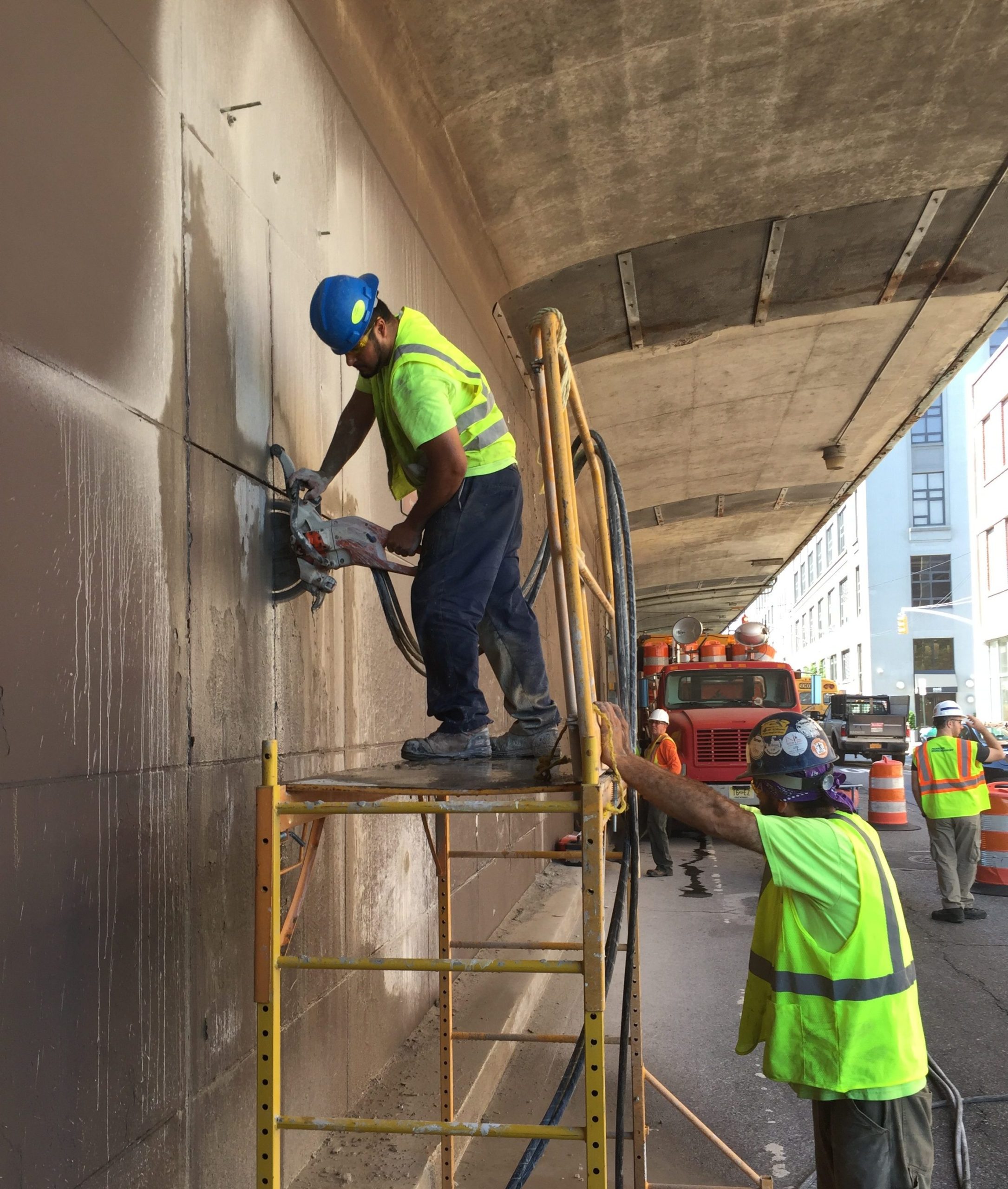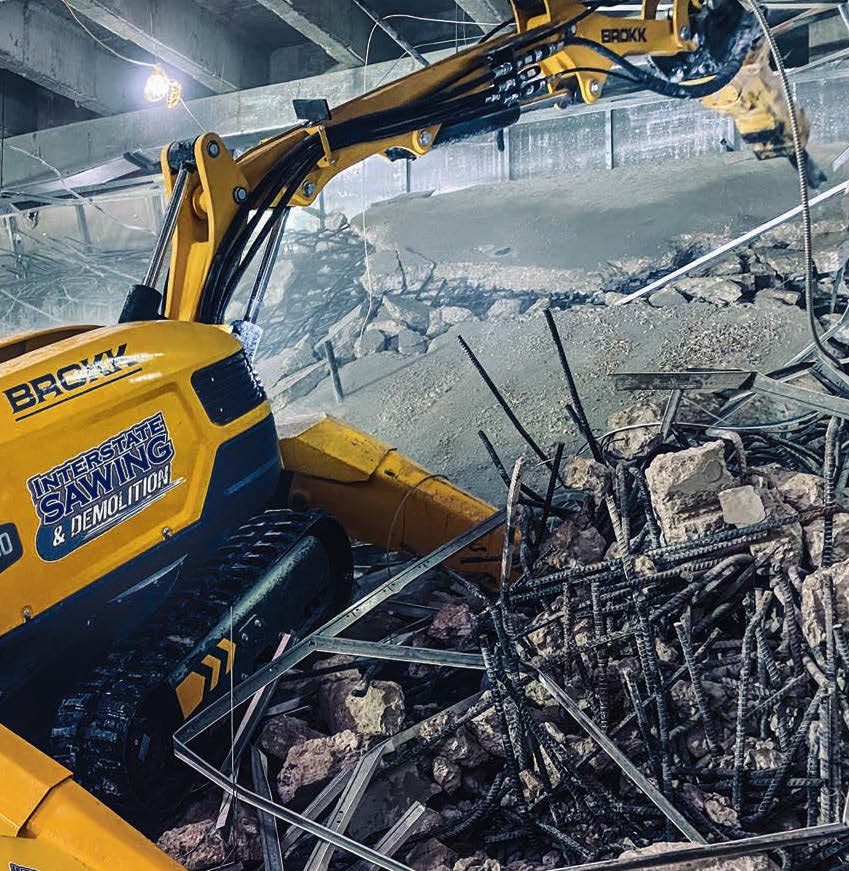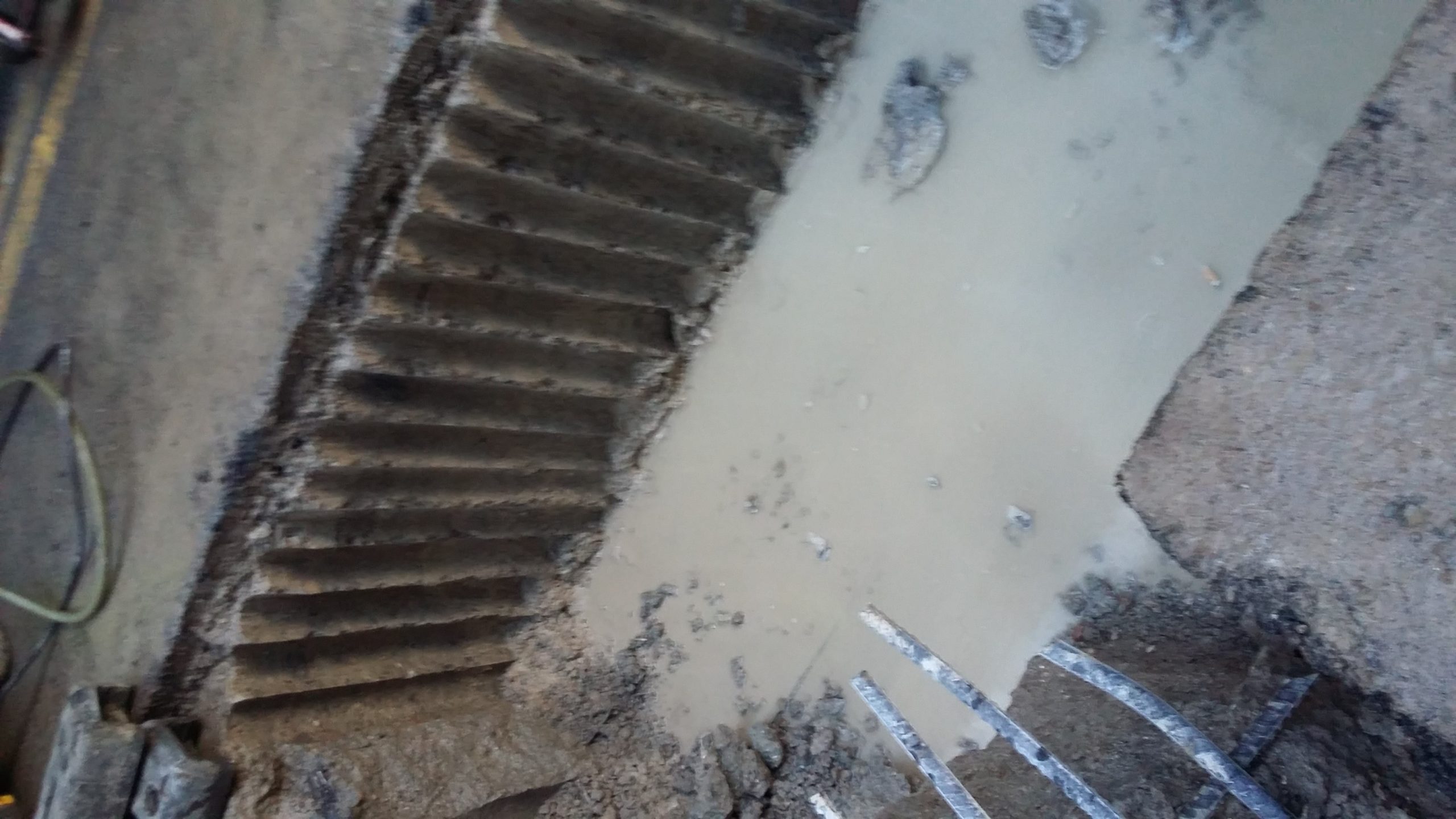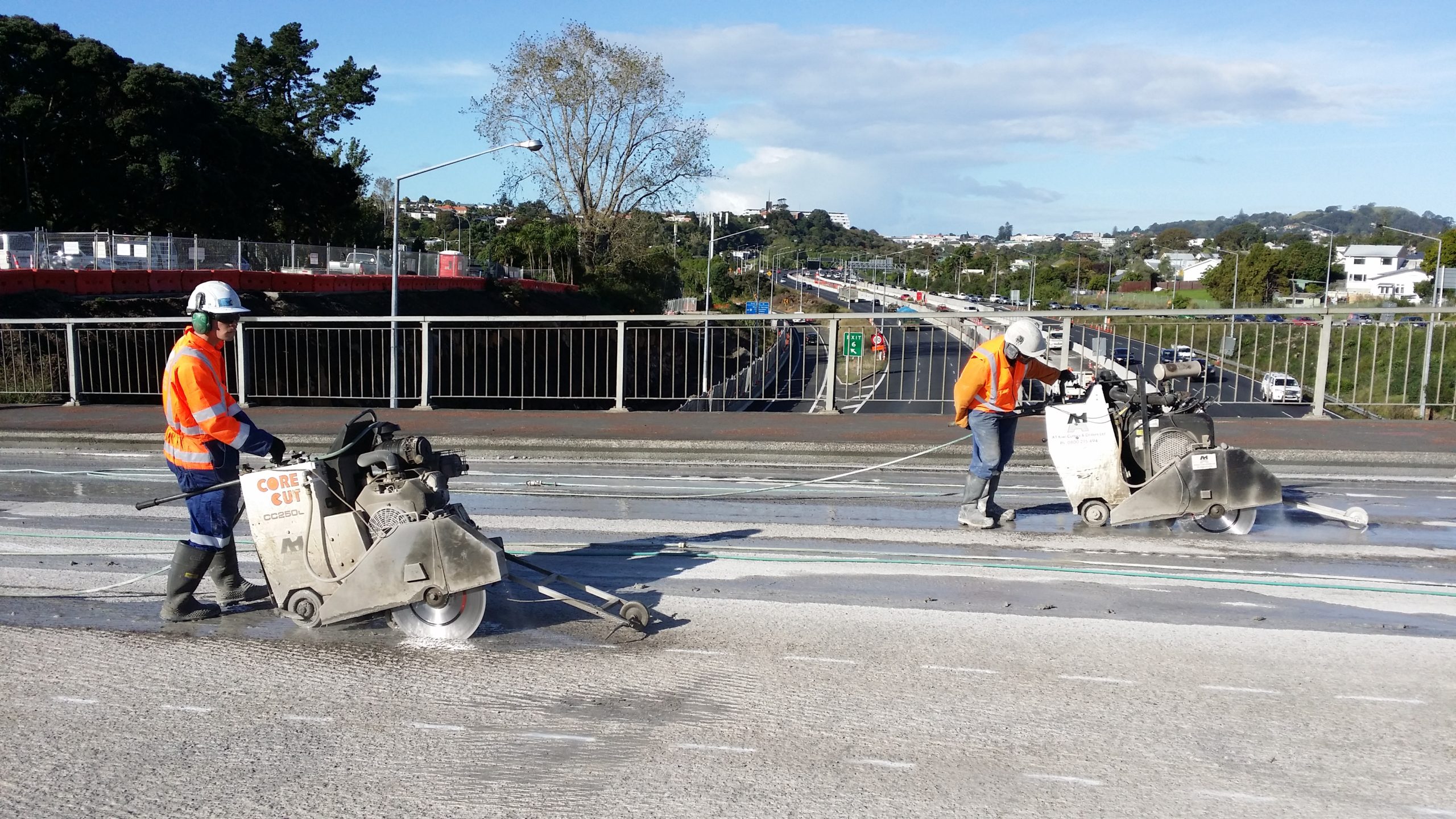
Brooklyn-Queens Expressway

Diamond Cutter Provides Access for Critical Inspections of Aging Roadway
A general contractor in New York was recently tasked with the in-depth inspection of the Brooklyn—Queens Expressway’s (BQE) triple cantilever bridge as part of a $1.7-billion reconstruction project. The inspections specified a need for the creation of 3-foot-wide by 2-foot-tall access openings and door installations in the bridge structure, so the search began for a specialty sawing and drilling contractor to perform the work.
The New York City Department of Transportation’s BQE Atlantic to Sands Project is part of the City’s 10-year plan to improve the 0.4-mile-long reinforced concrete, multi-level structure. The planned construction will provide this section of roadway with a new deck, new ramps, new drainage and lighting with fewer joints and geometry improvements to create an overall safer drive for the 140,000+ commuters who use it each day.

Stone Facings were cut and removed so that 3-foot-wide by 2-foot-tall openings could be created.
Eastern Cutting Corp., a CSDA member based in The Bronx, New York, was chosen by general contractor Parsons Brinckerhoff, Inc. to saw cut openings in the exterior stone-facing wall of the bridge, which would allow access to enclosed areas for engineers to inspect existing conditions prior to the reconstruction process. The roadway, built almost 70 years ago, had already been deemed to be in desperate need of repair with some suggestions it was 10 years past its originally-intended lifespan. In order to avoid lengthy—and expensive—shutdowns in the coming years to carry out emergency repairs, the BQE Atlantic to Sands Project was devised.
“I believe we were selected for this particular project based on our past performance in and around New York City’s many high-profile construction projects,” explained Joseph Neos, owner of Eastern Cutting Corp. “The building of relationships with job specifiers and general contractors has proven to be the most vital factor in securing work on projects like the BQE.”
Between July and September 2016, operators from Eastern Cutting Corp. cut 3-foot by 2-foot openings into the wall at 38 locations along a stretch of the BQE from Atlantic Avenue to Sands Street. Wall thicknesses ranged from 30 to 46 inches deep at the majority of locations. Saw cutting and core drilling techniques with diamond tools were essential because of the thickness of the reinforced walls and, more importantly, the condition of the structure. The threat of damaging the structure with high-impact jackhammers meant a more precise method was sought. Wall sawing and core drilling equipment could achieve the specified depths without overcutting the reinforced, load-bearing walls, and the removal of stone and concrete was to be kept to a minimum.
“We had to educate the general contractor on the benefits using diamond tools and convince them we had the most suitable method. Referencing past jobs, where we had used concrete chain saws, ring saws and stitch drilling techniques, paved the way for us to win the work. Site visits and a means and methods breakdown, along with an aggressive schedule, got us the job,” said Neos.

Stitch drilling techniques were employed, using 4-inch-diameter bits.
The thickness of the walls proved to be the biggest challenge for the cutting contractor. Single-sided access ruled out conventional wire sawing methods. Help and suggestions were provided via the CSDA Forum for Professionals Facebook group, where other members gave advice that ultimately led Eastern Cutting Corp. to use stitch drilling and chain sawing techniques. Another major obstacle was time. A limited window of time was granted for work during each day or night. Lane closures for certain sawing locations were restricted to four or five hours per shift. Operators held nightly meetings to address cutting sequences prior to commencing work, which ensured that time on-site was being used as effectively as possible.
To create the access openings, operators first need to cut through the 12-inch-thick stone facing that covered the concrete structure. Ring saws supplied by Husqvarna Construction Products and an 890F4 ICS chain saw, powered by hydraulic power packs from Reimann & Georger Corporation, were employed to cut a 4-foot by 3-foot area, after which the facing was removed to reveal the concrete wall behind.
From this point, DD200 and DD350 core drills from Hilti were used to perform stitch drilling techniques to make the specified 3-foot by 2-foot access openings. Approximately 30 holes measuring 4 inches in diameter were drilled to depths between 30 and 26 inches deep to create a rectangle-shaped piece for removal. Time was taken to securely mount the core drill rig to the vertical structure for each horizontal hole and it took approximately 15 hours to complete one set of holes. The contractor went on to complete 38 of these openings in total.
All work was performed in streets and highways, which came with safety concerns. Temporary lane closures were initiated, but often the width of the remaining roadway was insufficient to allow for a traffic lane, bicycle lane and the existing parking lane. A work zone traffic control plan was implemented to allow operators to safely work.

The contractor was tasked with creating openings in the expressway for structural inspections.
In addition to the access openings via the exterior stone facing, Eastern Cutting Corp. was also tasked with creating a series of interior wall openings within the BQE structures. These openings consisted of making 15 holes 24 inches in diameter through 30-inch-thick concrete walls. Each of these holes took around 50 minutes to complete. As some of this work was done in confined spaces, the contractor provided its own confined space training and all necessary equipment, including ventilation and lighting, to maintain operator safety.
Total time allotted for completion of the work was 120 days, but Eastern Cutting Corp. succeeded in finishing all tasks in just 79 days. The contractor created 38 openings, stitch drilled 400 holes, completed 380 linear feet of 12-inch-thick sawing by hand, made 15 interior holes at 24 inches in diameter and created 45 pilot holes 4 inches in diameter.
Engineers then conducted several tests on the concrete and discovered that it had badly deteriorated because of cold weather, and that a few more freezing winters would have sped up the damage. There were also many leaky joints found that were causing extra wear and tear on the BQE.
As a result of the cutting contractor’s early completion and professional work, additional work and invitations to bid on similar projects were awarded. This was extremely satisfying for Neos and his team.
“We were very satisfied with our company performance. Our crews worked around the clock without incident and completed the work well under our time frame. From performing test cuts in our shop to actually performing the work at night on a busy expressway under tight time constraints, our crews stepped up to the challenge,” he said.
Repairs to the BQE are expected to begin in 2024 and end in 2029, although they could be done between 2021 and 2026 if the state of New York passes legislation to allow the city Department of Transportation to use the same contractor for design and construction.
Company Profile
Eastern Cutting Corp. originally joined the CSDA membership in 2008 and is based in The Bronx, New York. The company has been in business for nine years, has 25 employees and 10 trucks. Eastern Cutting Corp. offers the services of core drilling, wall sawing, wire sawing, flat sawing, selective demolition and ground penetrating radar.
Resources
General Contractor:
Parsons Brinckerhoff, Inc.
Sawing and Drilling Contractor:
Eastern Cutting Corp.
The Bronx, New York
Phone: 718-361-6123
Email: joe@easterncutting.com
Website: www.easterncutting.com
Methods Used: Core Drilling, Hand Sawing














